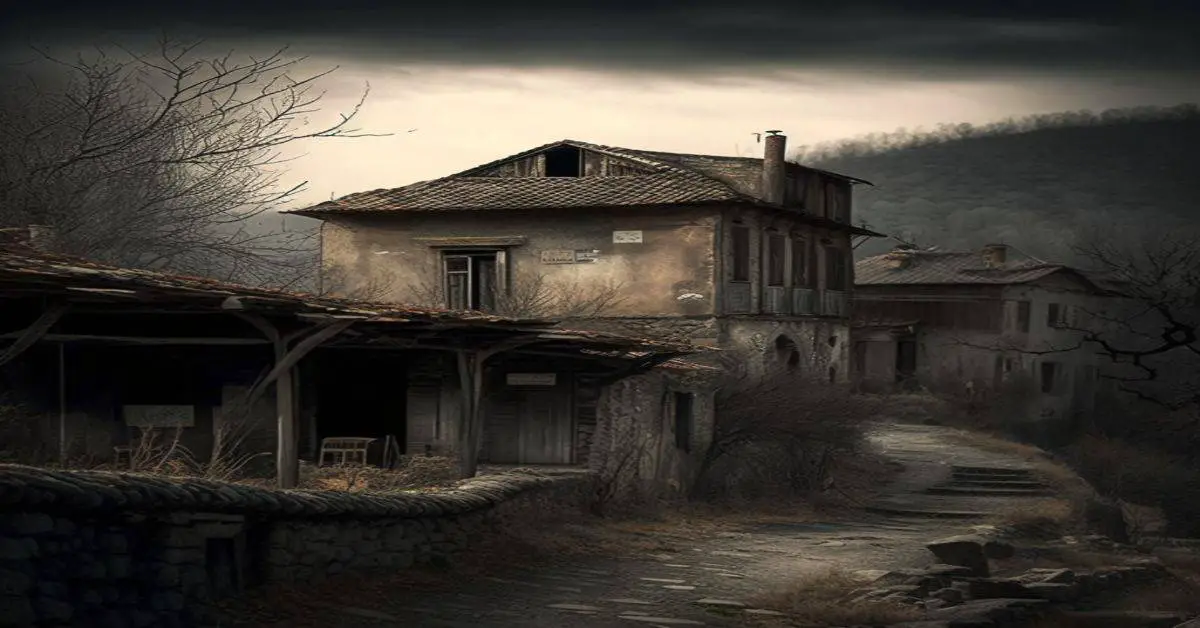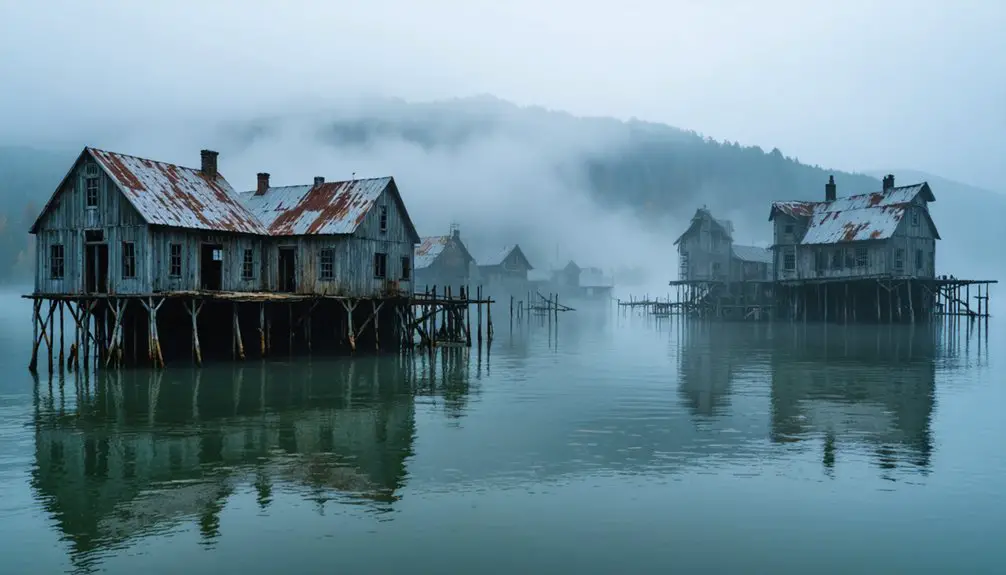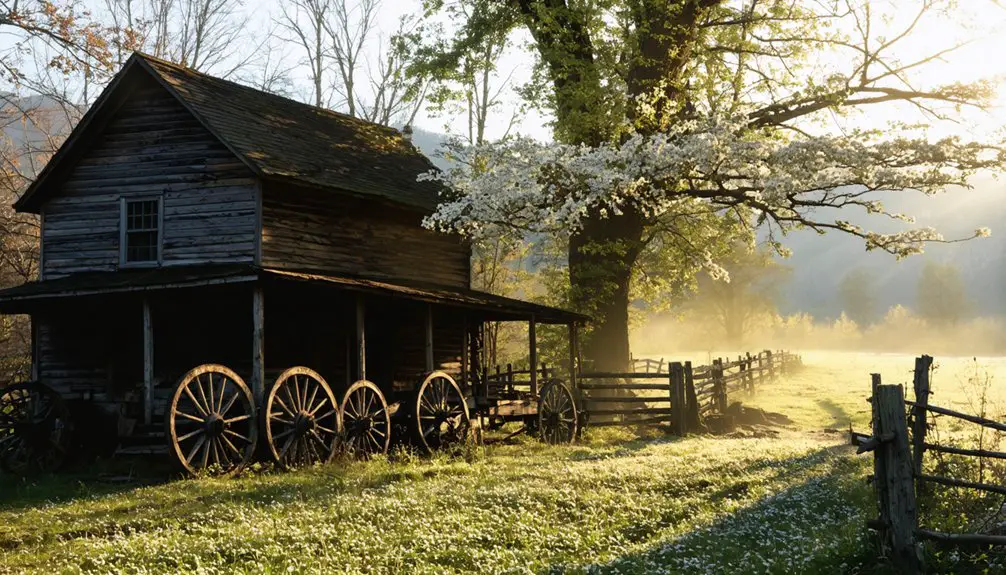You’ll find Olympus, Tennessee – established in 1834 in Overton County – now submerged beneath Dale Hollow Lake‘s waters. This ghost town’s post office served as a crucial community hub until 1907, while also earning distinction as the birthplace of Nobel Peace Prize winner Cordell Hull in 1871. The town’s transformation came in the 1940s when the Flood Control Act created the 27,700-acre reservoir, forever changing this slice of Appalachian history. The story beneath those waters holds fascinating secrets of early American rural life.
Key Takeaways
- Olympus, Tennessee was established in 1834 and became a ghost town after its post office closed permanently in 1907.
- Much of the original town site now lies submerged beneath Dale Hollow Lake, created in the 1940s.
- The town was the birthplace of Nobel Peace Prize winner Cordell Hull and centered around the Grimsley family’s influence.
- Economic decline began after an 1883 fire at W.B. Grimsley’s store, a vital commercial center for the community.
- The community relied on farming and small-scale trade but struggled due to lack of major industries or transportation links.
The Rise and Fall of a Rural Community
While many Tennessee ghost towns emerged from failed industrial ventures, Olympus stands out as a rural community that rose and fell with the rhythms of agricultural life.
You’ll find its origins traced to 1834, when the establishment of a post office marked its official beginning in Overton County. The community dynamics centered around the influential Grimsley family, who served as postmasters and anchored local life around their homestead.
The rural identity of Olympus reflected typical Appalachian patterns, with residents relying on farming and small-scale trade. Much like the early settlers of first settlers in Elkmont during the mid-1800s, these pioneers sought to build their lives through hunting and homesteading. Unlike the bustling tourist destinations of Gatlinburg and Pigeon Forge, which draw millions of visitors today, Olympus remained a quiet farming settlement throughout its existence.
You’ll notice how its location, about three miles northeast of the Obey River, connected it to neighboring settlements like Huntersville and Monroe. Yet without major industries or transportation links, the community struggled to maintain its population, leading to intermittent closures of its post office and eventual decline.
Notable History of the Post Office
The establishment of the Olympus post office in 1834 marked a pivotal moment in Overton County’s development, with W. B. Grimsley and Harvey Ryan’s store serving as the initial postal communication hub.
You’ll find the post office’s story intertwined with the community’s evolution, reflecting the region’s dynamic changes through multiple relocations and reestablishments. Like its namesake Mount Olympus in Greece, the town once stood prominently in Tennessee’s landscape.
The Grimsley and Ryan store became a central gathering place where local men discussed the organization of the new county.
- The post office operated as an essential community hub, connecting residents to broader networks while supporting local commerce.
- Your ancestors would have witnessed the post office’s various locations, including one site now submerged beneath Dale Hollow Lake.
- Through periods of discontinuance and reestablishment, you can trace the area’s population shifts and economic changes.
- Records show the final closure in 1907, after serving generations of rural Tennesseans through their pursuit of independence.
Birthplace of a Nobel Peace Prize Winner
Beyond its postal history, Olympus gained international recognition as the birthplace of Cordell Hull, who’d become America’s longest-serving Secretary of State and win the 1945 Nobel Peace Prize. Born in this rural Tennessee community on October 2, 1871, Hull’s early life in Olympus shaped his values before he initiated a remarkable career in public service. His dedication to international cooperation earned him recognition when he was awarded the prize on November 12, 1945. You’ll find that his Nobel legacy extends far beyond this now-vanished town, as he earned the title “Father of the United Nations” through his peace diplomacy efforts. While Olympus no longer exists due to geographic changes and development, its significance endures through Hull’s achievements, including his vital work establishing the UN and implementing the Good Neighbor policy that transformed U.S.-Latin American relations. After his passing in 1955, he was interred in Washington Cathedral, where a memorial marker honors both him and his wife.
Geographic Changes and Dale Hollow Lake
Located approximately three miles east of Celina, Tennessee, Dale Hollow Lake fundamentally transformed the region’s geography when its construction submerged multiple communities, including parts of Olympus, beneath its waters.
The geographic transformations that occurred in the 1940s reshaped the landscape across six counties in Tennessee and Kentucky, creating a 27,700-acre reservoir. This massive undertaking was initiated through the Flood Control Act to manage the Obey River’s floodwaters. The area now attracts three million visitors annually for recreational activities.
You’ll find the remnants of Willow Grove and other settlements preserved as submerged landscapes, visible only to scuba divers.
The original Celina (“Old Town”) relocated to higher ground due to flood risks at the junction of the Obey and Cumberland rivers.
Former homes, churches, farms, and even grave markers rest silently beneath the water’s surface.
The valley’s conversion into Dale Hollow Lake altered natural habitats while creating new opportunities for outdoor recreation.
Life in 19th Century Olympus
You’d find daily life in Olympus centered around its post office, which served as an essential hub for communication and commerce from 1834 until 1907.
Your social interactions would’ve revolved around the community building, where the Masonic Hall hosted fraternal gatherings upstairs while Smyrna Academy educated local children below.
The daughter of David Alexander Verble, Sarah Verble, resided in Tennessee during this period as documented in the 1860 census.
W.B. Grimsley’s store burned down in April 1883, devastating the small community’s economic stability.
If you’d lived in Olympus during the 19th century, you would’ve participated in a close-knit rural community where postal services, education, and social organizations formed the backbone of daily activities.
Daily Commerce Activities
Daily commerce in 19th-century Olympus revolved around crucial enterprises that served the town’s agricultural and industrial needs.
You’d find the general store at the heart of daily trading, where farmers and townspeople gathered to purchase supplies and exchange news. Agricultural markets flourished as the backbone of local commerce, connecting producers directly with buyers.
The town’s commercial activities centered around:
- The general store, which stocked crucial goods and often housed the post office
- Blacksmith shops providing crucial repair services for farm equipment and horse shoeing
- Local agricultural trading posts where farmers sold their harvests
- Processing facilities for tobacco and grain, preparing crops for broader markets
These commercial hubs created a self-sustaining economy that supported both local needs and regional trade connections.
Church and Community Life
As congregations gathered in Olympus during the nineteenth century, religious life became deeply interwoven with the social fabric of the community. You’d find church gatherings serving multiple purposes, from Sunday worship to town meetings where local matters were discussed and news was shared.
The Methodist and Baptist denominations dominated the region’s spiritual landscape, while the Third Great Awakening brought revival meetings that energized the community.
Your church involvement would’ve extended beyond Sunday services. Community outreach efforts, inspired by the Social Gospel movement, provided care for those in need.
Churches also functioned as educational centers, with Sunday schools teaching both biblical literacy and basic reading skills. The buildings themselves stood as essential community hubs where baptisms, weddings, and funerals marked life’s significant moments.
Post Office Operations
One of the earliest post offices in Overton County emerged in Olympus during 1834, marking the beginning of formal postal operations in this Tennessee plateau community. The postal service played a crucial role in rural infrastructure, serving as a lifeline for commerce and communication.
You’ll find these notable aspects about Olympus’ post office operations:
- Located within local stores, including one owned by W.B. Grimsley and Harvey Ryan
- Experienced multiple closures and reopenings throughout the 19th century
- Served as a community hub for news, information, and business transactions
- Finally closed its doors in 1907, with one location now submerged under Dale Hollow Lake
The post office’s intermittent operation reflected the economic ups and downs of this frontier settlement, following patterns common to many rural Tennessee communities of that era.
Legacy and Historical Significance
While Olympus’s physical presence has largely vanished beneath Dale Hollow Lake, the town’s enduring legacy stems primarily from its connection to Cordell Hull, the 47th U.S. Secretary of State.
Through historical preservation efforts, you’ll find that Olympus represents a compelling example of how small Appalachian communities faced dramatic changes during the 20th century.
Community remembrance continues through genealogical research and local historical archives, despite the town’s physical remains being limited by the lake’s creation.
You’ll discover that Olympus’s story mirrors many Tennessee ghost towns that faded due to modernization and infrastructure changes.
The town’s documentation, primarily through postal records and Hull’s biographical connections, provides valuable insights into rural settlement patterns and the impact of progress on traditional communities.
Frequently Asked Questions
What Native American Tribes Originally Inhabited the Olympus Area?
You’ll find Cherokee history dominates this region, with their Overhill Towns establishing strong roots along nearby rivers, though Native folklore suggests earlier Woodland peoples and some Yuchi also called these lands home.
Were There Any Churches or Schools Established in Olympus?
Like footprints in shifting sand, you’ll find no solid records of church history or education facilities here. Historical documents don’t confirm any established churches or schools in this remote community.
What Were the Main Occupations and Industries of Olympus Residents?
You’d find residents working in logging, sawmills, railroad logistics, trade, and hospitality services. They balanced these commercial jobs with traditional agriculture practices like farming and hunting for sustenance.
Did Any Civil War Battles or Significant Military Events Occur Near Olympus?
You’ll find significant Civil War military activity nearby, with the Battle of Stones River just 12 miles away. Local skirmishes at Beach Creek Bridge and Big Creek Gap shaped regional control in 1863.
Are There Any Remaining Structures or Ruins Visible Above Dale Hollow Lake?
You won’t find prominent remaining structures visible above Dale Hollow Lake today, as most ruins lie underwater. Unlike some other Tennessee reservoirs, there aren’t documented standing structures breaking the lake’s surface.
References
- https://www.youtube.com/watch?v=fhx4rv3iW-s
- https://www.tnmagazine.org/19-ghost-towns-in-tennessee-that-are-not-underwater/
- https://wbkr.com/historic-mountain-ghost-town-awaits-your-next-east-tn-visit/
- https://en.wikipedia.org/wiki/Olympus
- https://tngenweb.org/ofp/olympus-community-pickett-county/
- https://gatlinburghaunts.com/elkmont-tennessees-ghost-town/
- https://en.wikipedia.org/wiki/List_of_ghost_towns_in_Tennessee
- https://kids.kiddle.co/List_of_ghost_towns_in_Tennessee
- https://www.wikiwand.com/en/articles/Olympus
- https://dalehollow.com/tour/Olympus.htm



